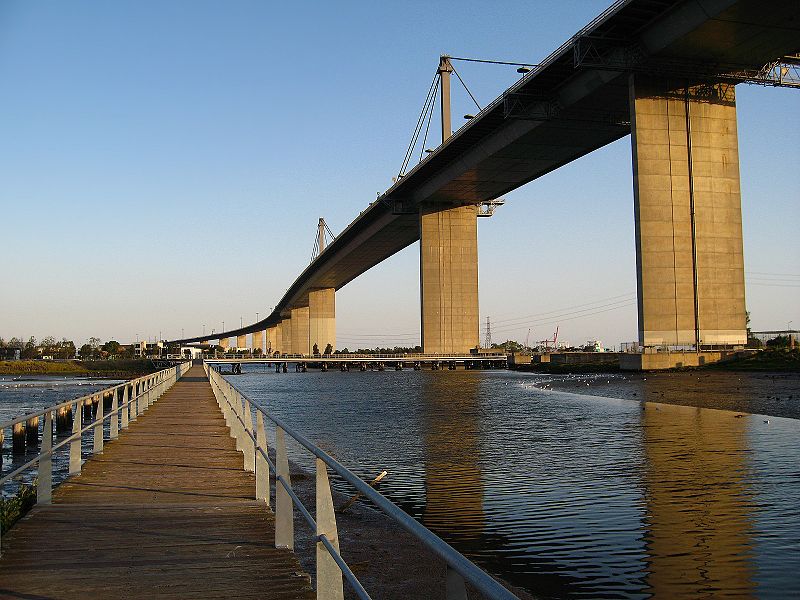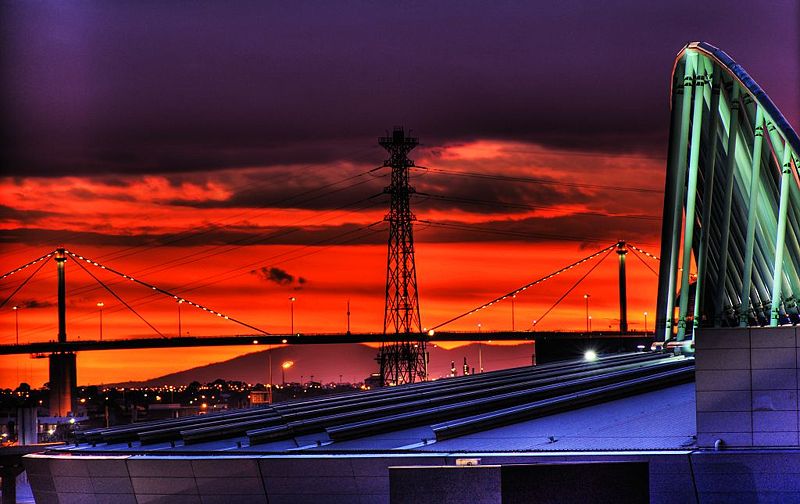| |||||||
Europe
North AmericaSouth AmericaAsiaAustralia and OceaniaAfrica |
Смотрите также: West Gate Bridge The West Gate Bridge is a large cable-stayed box girder bridge in Melbourne, Victoria, Australia. It spans the Yarra River, just north of its mouth into Port Phillip, and is a vital link between the inner city and Melbourne's western suburbs with the industrial suburbs in the west and with the city of Geelong, 80 kilometres (50 mi) to the south-west.
West Gate Bridge Carries 8 lanes (4 inbound, 4 outbound) Crosses Yarra River Locale Melbourne, Australia Design Cable-stayed box girder Longest span 336 metres (1,102 ft) Total length 2,582.6 metres (8,473.1 ft) Width Maximum of 37.3 metres (122.4 ft) Clearance below 58 metres (190.3 ft) Opening date 15 November 1978
The main river span is 336 metres (1,102 ft) in length, and the height above the water is 58 metres. The total length of the bridge is 2,582.6 metres (8,473.1 ft). It is the third longest in Australia behind the Houghton Highway and the Hornibrook Bridge, and is twice as long as the Sydney Harbour Bridge. The bridge passes over Westgate Park, a large environmental and recreational reserve created during the bridge's construction.
History Collapse Two years into construction of the bridge, tragedy struck at 11.50 am on 15 October 1970, the 112 metre (367.5 ft) span between piers 10 and 11 collapsed and fell 50 metres (164 ft) to the ground and water below. Thirty-five construction workers were killed. Of those who perished many were located beneath the structure in workers' huts which were crushed by the falling span. Others were working on and inside the girder when it fell. The whole 2,000-tonne mass plummeted into the Yarra River mud with an explosion of gas, dust and mangled metal that shook buildings hundreds of metres away. Homes were spattered with flying mud. The roar of the impact, the explosion, and the fire that followed, could be heard some distance away. A West Gate Bridge Memorial to workers who lost their lives is located near the bridge. On the following morning, October 16, Sir Henry Bolte (Premier of Victoria) announced that a Royal Commission would be set up immediately to look into the cause of the disaster. The Prime Minister, Mr. John Gorton, said: "I am sure the whole of Australia is shocked and saddened by the serious accident at West Gate Bridge . Please extend my deepest sympathy to all those families to whom this tragic event has brought such grief."
Cause A Royal Commission into the collapse was established, and concluded on 14 July 1971. It attributed the failure of the bridge to two causes; the structural design by designers Freeman Fox & Partners and an unusual method of erection by World Services and Construction, the original contractors of the project.
On the day of the collapse there was a difference in camber of 11.4 centimetres (4.5 in) between two half girders at the west end of the span which needed to be joined. It was proposed that the higher one be weighted down with 10 concrete blocks, each 8 tonnes (11 t), which were located on site. The weight of these blocks caused the span to buckle, which was a sign of structural failure. The longitudinal joining of the half girders was partially complete when orders came through to remove the buckle. As the bolts were removed the bridge snapped back and the span collapsed. Six twisted fragments of the collapsed bridge can be found adorning the gardens in the engineering faculty of Monash University, Clayton campus. It is said by students that they are to remind engineers of the consequences of their errors. Monash University acquired these when asked to participate in the investigation of the collapse. Completion Completed in 1978 after 10 years of construction, the bridge, a part of the larger West Gate Freeway, cost $202 million. The bridge was originally tolled. Tolls were abolished in 1985, because drivers were using other routes to avoid the toll. In 2006 the State Government spent $1.3 million on erecting railway style boom barriers at each entrance to the bridge to block traffic in the event of a terrorist attack. In March 2007 the State Government announced that two flagpoles would be erected atop the main bridge pylons, to fly the Australian and Victorian flags, each being 10 metres by 5 metres in size and 135m above sea level. Costing $350,000 to install and $15,000 a year to maintain,[6] the flags were unfurled on September 24, 2008.
Future Strong growth in suburbs along the route, and increased freight through the Port of Melbourne, means that the corridor is experiencing traffic congestion during peak periods, is vulnerable to short term interruptions and is rapidly approaching capacity.
Proposals to abate congestion by allowing more traffic have included bridge widening, a tunnel underneath the river, or adding a second deck to the bridge. Many such plans have come under fire from community groups such as the Public Transport Users Association and Environment Victoria advocating investment in alternative forms of transport. The bridge was strengthened with carbon fibre reinforced polymers (CFRP) in 2002. On 17 May 2006, the State Government announced plans to change traffic flow in peak periods on the West Gate Bridge and approaches to it, providing five traffic lanes in the peak direction, instead of four. This will be done using overhead signals and barriers. The state government has allocated funds to this project in its 2006–2007 state budget. On 5 August 2007 it was reported that the Victorian Government was planning a $240 million project to identify and eliminate structural weaknesses in the bridge, with specific concerns including crash barriers, cracking, corrosion and potential buckling. News of the work was prompted by the collapse of the I-35W Mississippi River bridge in Minneapolis, Minnesota, United States. Experts were reported as saying the West Gate was initially designed to carry loads of 25 tonnes but now carried B-double trucks weighing up to 68 tonnes. It was also built to carry 40,000 vehicles a day, but volumes are now more than four and a half times the original amount, approximately 180,000 vehicles on an average day. The State Government is also assessing options for the development of another east-west link. Sir Rod Eddington, former CEO of British Airways and Chairman of the Victorian Major Events Company, will head the assessment of the future East-West connections and recommend the best way forward for public transport, road and freight travel for the entire Monash-West Gate corridor. An unconfirmed 6 February 2006 report suggested that the State Government was considering plans to build a companion tunnel to the West Gate Bridge, the Westgate Tunnel under the Yarra River, to carry both traffic and a freight rail line. This would be similar to the Sydney Harbour Bridge and Tunnel arrangement (although the latter does not provide a rail route).
Suicide and other deaths Police data show up to one suicide happens every three weeks at the West Gate Bridge. In 2008, the bodies of a mother in her late 20s and her 18-month-old baby were found on the river bank below the West Gate Bridge, prompting calls to erect a suicide barrier. Those who argue for a suicide barrier claim that most of those who jump from the West Gate Bridge do so through impulse and that police officers who try to save those who try to jump are putting their own lives in danger. There are multiple incidents of police officers dangling off the side of the bridge while holding onto would-be jumpers. A 2000 Royal Melbourne Hospital study on people who jumped from the bridge found at least 62 cases between 1991 and 1998. Seven people survived the 58-metre fall. Seventy-four per cent of those who jumped from the bridge were male, with an average age of 33. More than 70 per cent were suffering from mental illness. Of those who jump off the West Gate Bridge, 31 per cent fell on land. Some of those who land in water drowned afterwards. Comments: 0 |
|
|||||









































